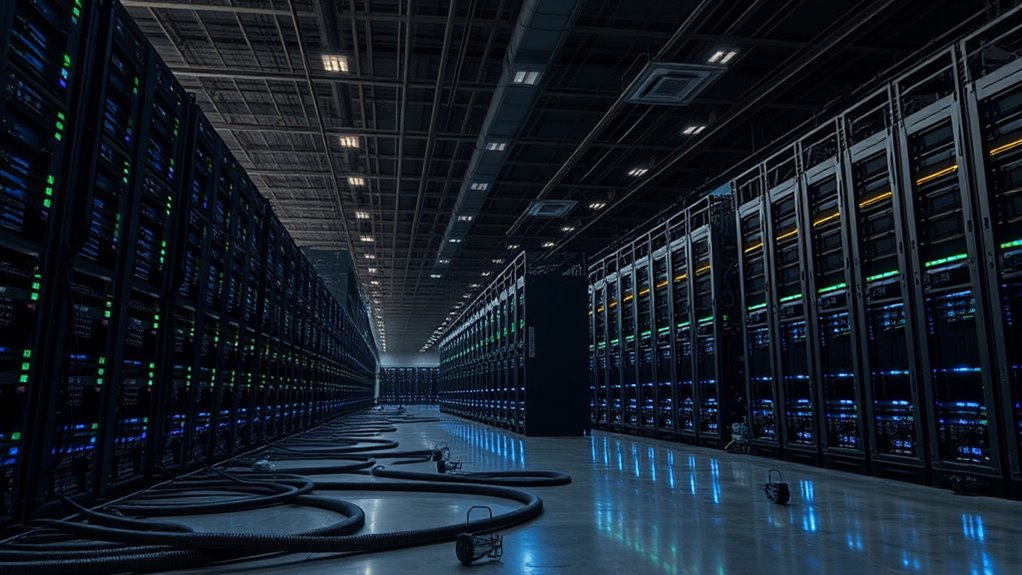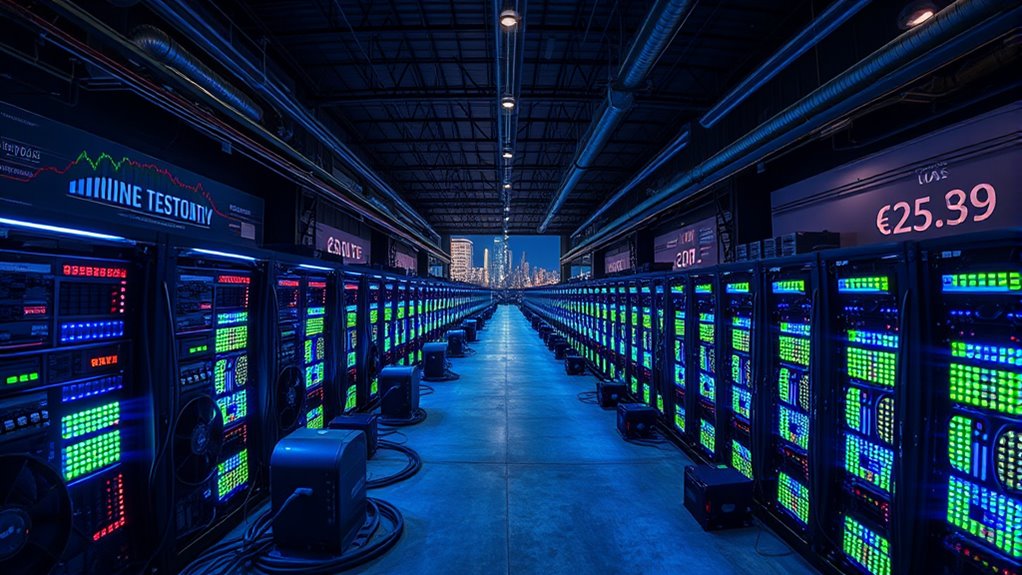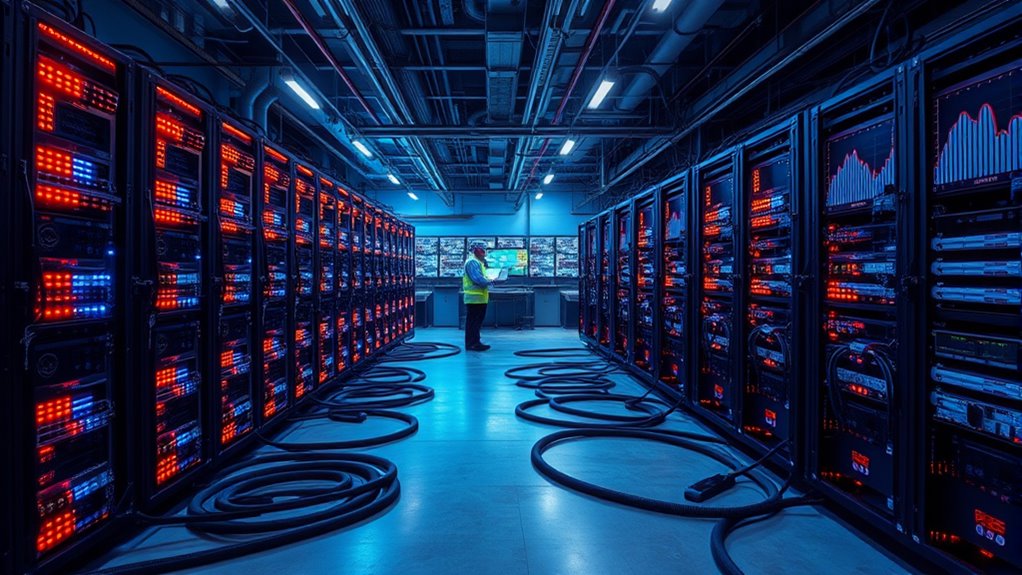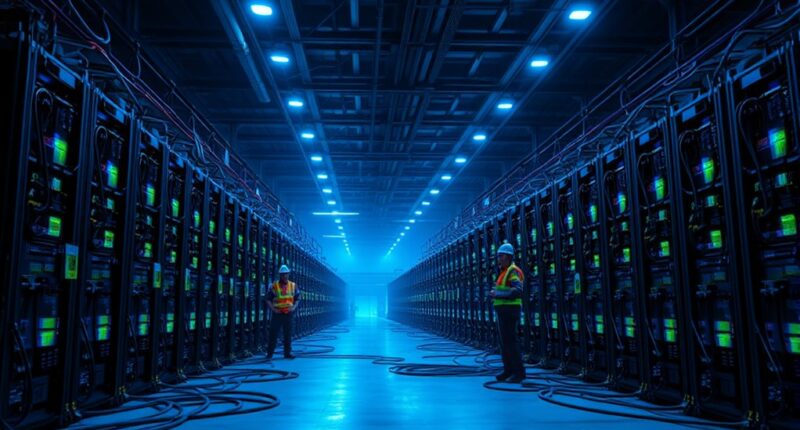Bitcoin’s mining difficulty has hit an all-time high, driven by U.S. miners expanding their operations and deploying advanced hardware. This increase boosts network security and signals strong industry confidence. As difficulty rises, miners face higher costs and tighter profit margins, especially those with older equipment. If you want to understand how these trends impact profitability and what the future holds for Bitcoin mining, there’s more to explore below.
Key Takeaways
- Bitcoin mining difficulty has reached an all-time high of approximately 146.72 trillion, reflecting increased network competition.
- U.S. miners are expanding infrastructure, contributing significantly to the ongoing difficulty growth.
- Rising difficulty enhances network security but squeezes profit margins, especially for older hardware.
- Technological advancements and hardware improvements are driving higher hashrates and difficulty adjustments.
- Industry strategies focus on operational efficiency and infrastructure upgrades to maintain competitiveness amid record difficulty.
Current State of Mining Difficulty and Network Security

The Bitcoin network is currently experiencing its highest mining difficulty ever, with a value of approximately 146.72 trillion. This elevated difficulty shows how much the network’s security has strengthened, as more powerful hardware and increased mining activity are making it harder to find new blocks. High difficulty guarantees the stability of the 10-minute block time, even with fluctuating hashrates. It also signals strong network health, as miners continue to invest in infrastructure, keeping the blockchain resilient against attacks. Additionally, diversify investments in mining equipment and strategies can help miners adapt to changing network conditions. Despite recent fluctuations, the overall trend remains upward, indicating sustained confidence and commitment from miners worldwide. This increased difficulty not only secures the network but also demonstrates how Bitcoin’s decentralized consensus mechanism adapts to ongoing growth and competition.
Recent Trends and Variations in Hashrate

Recent data shows that Bitcoin’s hashrate has experienced notable fluctuations even as mining difficulty reaches record highs. Over the past few months, the global hashrate has varied, reflecting shifts in mining activity and hardware efficiency. Despite recent dips, the overall trend remains upward, driven by U.S. expansion and new hardware deployments. The hashrate hit a peak of over 1,400 EH/s in September but dropped slightly afterward. These fluctuations often correlate with changes in network difficulty, block times, and miner behavior. As miners adjust their operations, the hashrate responds accordingly, maintaining network security. Understanding these trends helps you gauge the network’s resilience, miner investment strategies, and the evolving competitive landscape in mining. Additionally, color accuracy improvements in mining hardware can influence efficiency and performance.
Impact of High Difficulty on U.S. Mining Operations

As mining difficulty hits new highs, your margins are getting squeezed, especially if your equipment isn’t the latest model. To stay profitable, you’ll need to invest in upgrades that improve power efficiency and reduce costs. Without these improvements, competing in an increasingly tough environment becomes even more challenging. Implementing encryption solutions can also enhance the security of your operational data and protect your infrastructure from cyber threats.
Margins Under Pressure
High mining difficulty directly squeezes profit margins for U.S. operators, especially those relying on older, less efficient equipment. As difficulty climbs, your costs per mined Bitcoin increase, reducing overall profitability. You face tougher competition, forcing you to operate more efficiently or upgrade hardware. The declining hashprice—around $51–$52—further diminishes revenue per unit of hashrate. With higher energy consumption and operational expenses, margins tighten, putting pressure on smaller or outdated setups. Many miners now need to improve power efficiency or scale up to stay profitable. This environment favors large-scale, modern operations capable of absorbing higher costs. If you can’t adapt quickly, profitability drops, and you risk falling behind as the network’s difficulty continues to rise. Additionally, automation technologies are increasingly being adopted to help optimize operations and reduce costs.
Need for Upgrades
With mining difficulty at an all-time high, U.S. operators are feeling the pressure to upgrade their hardware and infrastructure. To stay competitive and maintain profitability, you need efficient, modern equipment that can handle increased hashrate demands. Outdated rigs struggle to keep up, squeezing margins further. Upgrading your fleet can reduce energy costs and improve hash efficiency, key factors in a high-difficulty environment. The table below highlights critical upgrade priorities:
| Upgrade Priority | Benefit |
|---|---|
| Hardware Refresh | Increased hashing power, lower costs |
| Power Efficiency | Reduced energy expenses |
| Cooling Systems | Prevents overheating, maintains uptime |
| Infrastructure | Supports higher capacity, scalability |
| Monitoring Tools | Optimizes operations, detects issues |
These upgrades are essential for survival and growth in a challenging mining landscape. Additionally, implementing efficient cooling systems can significantly enhance equipment longevity and overall operational stability.
Economic Factors Shaping Miner Profitability

Economic factors critically influence miner profitability, especially in a market characterized by rising difficulty and fluctuating revenue. When mining costs, like electricity and hardware, increase, your profit margins shrink unless Bitcoin’s price rises accordingly. Conversely, a drop in Bitcoin’s value can make mining unprofitable, forcing some operators to shut down. You also need to deliberate the hashprice, which has fallen to around $51–$52 per PH/day, putting pressure on earnings. Additionally, the efficiency of your hardware impacts your competitiveness—older equipment struggles to stay profitable. External factors such as regional electricity costs, hardware upgrades, and global competition shape your bottom line. Staying adaptable and optimizing operations are essential as these economic factors evolve. The efficiency of your hardware impacts your competitiveness and overall profitability.
Future Projections and Network Dynamics

As mining continues at its current pace, the network’s difficulty is expected to keep rising, reflecting ongoing hashrate growth. If this trend persists, difficulty could surpass the next estimated adjustment to 155.26 trillion, further solidifying network security. The faster-than-expected block times, averaging 9.45 minutes, suggest ongoing hashrate increases, which could trigger additional difficulty adjustments. Sustained high hashrate indicates strong miner confidence and investment, particularly in regions like the U.S., despite thinner margins. However, if profitability declines markedly for less efficient miners, network growth may slow, stabilizing difficulty. Over the long term, these adjustments aim to maintain 10-minute blocks, ensuring network stability and security as adoption continues. The future of network dynamics hinges on miner participation and pool operation and technological advancements.
Strategic Implications for the Mining Industry

The surge in Bitcoin mining difficulty demands that industry players reassess their strategic approaches to maintain profitability. To stay competitive, you need to focus on operational efficiency and cost management. Upgrading to more energy-efficient hardware is essential, as older equipment struggles with the rising difficulty. Diversifying your geographic footprint can reduce electricity costs and improve resilience. You should also monitor hashprice trends closely, adjusting your scale based on profitability margins. Collaborating with power providers or investing in renewable energy sources can lower operational costs. Additionally, exploring pooled mining options might optimize returns during periods of high difficulty. Staying agile and data-driven will help you navigate the challenges of higher difficulty while positioning for long-term growth. Incorporating well-being tips such as energy management strategies can enhance overall operational resilience.
Frequently Asked Questions
How Does Increasing Difficulty Affect Long-Term Bitcoin Network Security?
Increasing difficulty reinforces Bitcoin’s network security over the long term by making attacks more costly and less feasible. You’ll see that as difficulty rises, it requires more computational power to compromise the network, deterring malicious actors. This ongoing adjustment ensures the network stays resilient, even as miners expand and technology advances. So, higher difficulty helps keep Bitcoin secure, maintaining trust and stability for everyone involved.
What Technological Advancements Are U.S. Miners Adopting to Stay Profitable?
You’re adopting technological advancements like more efficient ASIC miners, which reduce power consumption and boost hashing power. Upgrading to newer hardware helps you stay competitive as difficulty rises, ensuring better margins despite lower hashprice. Additionally, you’re exploring renewable energy sources and optimizing cooling systems to cut operational costs. These innovations enable you to maintain profitability and secure your position in the increasingly competitive U.S. mining landscape.
How Will Upcoming Difficulty Adjustments Influence Global Mining Competitiveness?
You should know that with difficulty projected to rise by 5.82% in October 2025, global mining competitiveness will intensify. As difficulty climbs, only the most efficient miners will profit, pushing smaller operators out. This shift favors large-scale, technologically advanced farms, especially in regions with low electricity costs. Consequently, the industry will see increased consolidation, while innovation and operational efficiency become critical for staying competitive in an evolving, high-difficulty environment.
Are There Regions Outside the U.S. Poised to Dominate Future Mining Growth?
Regions outside the U.S., like Kazakhstan, Canada, and parts of Europe, are poised to dominate future mining growth. You should watch how these areas leverage low electricity costs, abundant renewable energy, and supportive regulations to attract miners. As U.S. expansion faces rising costs and saturation, these regions could become key players, especially if they upgrade hardware and improve infrastructure. Your focus should be on their energy policies and investment trends to understand their potential.
What Are the Environmental Impacts of Sustaining High Hashrate Levels?
You should know that sustaining high hashrate levels considerably impacts the environment due to increased electricity consumption and carbon emissions. As the network grows, mining operations require more energy, often sourced from fossil fuels, leading to higher greenhouse gases. This environmental footprint can contribute to climate change, especially if renewable energy isn’t prioritized. Minimizing these impacts depends on adopting cleaner energy sources and improving mining efficiency.
Conclusion
As mining difficulty reaches new heights, you face rising challenges and increased competition. You must adapt to shifting economic factors, optimize your operations, and stay ahead of network changes. You’ll need to monitor trends, respond to volatility, and seize opportunities in a dynamic landscape. Success depends on your ability to innovate, strategize, and persevere. Embrace the evolving environment, capitalize on growth, and secure your place in the future of Bitcoin mining.









